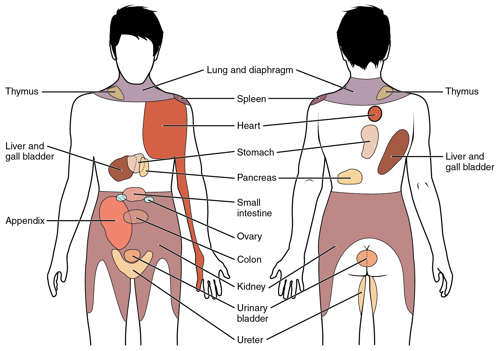There is great variability in the vertebral bodies within the thoracic spine. The upper thoracic vertebrae resemble cervical vertebrae and lower thoracic resemble lumbar vertebrae. In addition to this there are the additional articulations of the costovertebral and costotransverse joints with the ribs at all thoracic levels. Collectively the thoracic spine and ribs (as the chest wall) provide significant protection and stability. This is also enhanced by the thinness of the intervertebral discs.
The thoracic kyphosis is a primary curvature and its shape is determined by the vertebral bodies and discs. This kyphosis tends to increase with age but this change is also associated with reduced physical activity, poor postural habit, female gender and osteoporotic collapse. Increased kyphosis is generally asymptomatic.
The spinal canal is relatively narrow but the intervertebral foramen are relatively large. Therefore the incidence of radiculopathy in thoracic spine is much lower than in other areas of the spine. But, when present it is much more likely to be associated with symptoms of myelopathy. This creates a low incidence of radiculopathy but a higher rate of myelopathy in the presence of radiculopathy.
Spondylosis and bony degenerative changes are less evident within the upper and mid thoracic spine but a greater prevalence of Schmorl’s nodes (disc herniations within the central portion of the vertebral body) are seen on imaging but their clinical significance is unknown.
Movements of the thoracic spine are determined by direction and angle of the facet joints which varies from 0 - 90° in the different areas of the thoracic spine. But, overall segmental movement within the thoracic spine is much less than in the cervical or lumbar areas. Movement of the thoracic spine has rarely been investigated but it is cited that sagittal movements are greatest in the lower thoracic segments and rotation movements greatest in the upper thoracic segments. . With upper thoracic problems assessment of cervical spine movements need to be included and with lower thoracic spine problems, lumbar movements need to be included.


